Kick-Ass 2
Page 3 of 5

KICK-ASS IS REBORN
“Kick-Ass,” the revolutionary creator-owned comic that Mark Millar launched with artist John S. Romita Jr. in 2008, challenged curious readers with one simple question: “Why has nobody ever tried to become a superhero?” The two men answered that query with a barrage of violence, memorable characters and quotable dialogue.
Freshly buoyed by the blockbuster success of the Universal actioner Wanted—based on his same-titled book—Millar began to explore the possibility of bringing “Kick-Ass” to the big screen. Because “Kick-Ass” was an independent comic, this allowed the creators greater freedom in approaching production partners who would appreciate the series’ bracingly unique storylines.
Around that time, director Matthew Vaughn was looking for his next project and had recently been introduced to Millar by Stardust co-writer Jane Goldman and her husband, Jonathan Ross. Millar later pitched Vaughn a number of ideas, but it was Kick-Ass that resonated most. Vaughn was determined to apply the same anarchic spirit of the comic to the filmic version—even if that meant including scenes in which an 11-year-old Hit Girl mows down dozens of heavily armed men with an arsenal of weaponry and a string of expletives. When turned down by Hollywood’s major studios, Vaughn decided to finance Kick-Ass independently.
Scripted by Goldman and Vaughn, Kick-Ass brought to the screen the wild story of Dave Lizewski, an ordinary Manhattan teenager who sets out to become a real-life superhero. Donning a green-and-yellow wet suit and calling himself Kick-Ass, he captures the imagination of the public and becomes an online phenomenon. Kick-Ass soon discovers he is not the city’s only superhero when he meets a fearless and highly trained father-daughter crime-fighting duo—the cowl-draped Big Daddy and ninja assassin Hit Girl. As Kick-Ass becomes entangled in their quest to take down the criminal empire of local mafioso Frank D’Amico, our hero gains a nemesis of his own: Frank’s teenage son, Chris, who has taken to calling himself Red Mist.
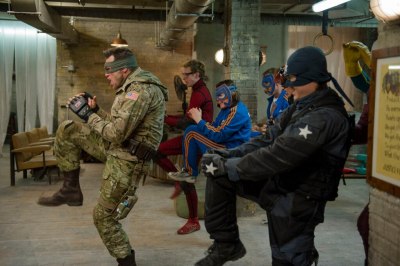
The movie was nothing short of a huge gamble, but one that the filmmakers were prepared to take. Kick-Ass was lensed in 2008, with Vaughn showing it to potential distributors a year later. He subsequently sealed deals with Lionsgate and Universal Pictures to release it in the U.S. and internationally, respectively, in 2010. Kick-Ass was met with astonishing reviews such as Richard Corliss’ Time magazine rave: “It soars, jet-propelled, on its central idea of matching a superhero’s exploits with the grinding reality of urban teen life and on the aerodynamic smoothness of the film’s style.”
Although the groundbreaking film caused some critics to raise their eyebrows in dismay, it was adored by audiences who understood Vaughn’s strong desire to upend the genre. In turn, the movie pulled in almost $100 million globally, proved enormously successful on DVD/Blu-ray metrics and gained a passionate following along the way.
All the while, Millar and Romita continued the work on their homegrown saga. The first chapter of their follow-up comic series, “Kick-Ass 2, Issue 1,” debuted on October 20, 2010. Set several months after the events of the first run, the books reconnect us with Mindy and Dave as they struggle to keep their identities as Hit Girl and Kick-Ass a secret—while she trains him to be a better hero who can take a much-less-forgiving punch. Meanwhile, Red Mist returns with an increasingly psychotic new attitude and an unprintable name change to match. Forming a group of super-villains, Chris takes the deadly game to the next level as he attempts to exterminate the duo that killed his reprobate father.
Twenty-four hours after its release, “Kick-Ass 2, Issue 1” sold out, and the “Hit Girl” companion title has since become the most popular comic book with a female lead in more than a decade. The first two chapters of the “Kick-Ass 3” series are currently in release, completing the trilogy and bringing Dave Lizewski’s story to an exciting finish later this year.
Millar walks us through the evolution of this sig-nature property: “Kick-Ass was about a guy deciding to become a superhero and influencing others to do the same. Kick-Ass 2 takes that idea and runs with it. Now we have this group of people who, inspired by the heroics of Kick-Ass, have formed a crime-fighting gang, Justice Forever. At the same time, Chris is embarking on the opposite journey. He has decided to become a self-proclaimed super-villain and is recruiting his own army. It takes something that was singular in the first movie and makes it into something more exciting. It’s that sense of escalation, of expansion, that you always want with a sequel.”
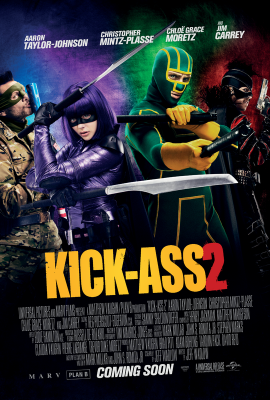
As Millar and Romita created the characters and own the rights to them, the two men take the fate of our every-day superheroes very seriously. Romita explains that he and Millar have just as much invested in the fate of Dave, Mindy and the other members of Justice Forever as the diehard fans do, and it is tough to create bad situations that happen to them. The artist says: “All of the interesting characters that are in Justice Forever, you want them to win. Here I am, a comic book artist, and I want these characters to be superheroes because I don’t want anything bad happening to them.”
Kick-Ass’ unexpected success, set the stage for a sequel; however, it would take a couple years for the next chapter to begin production. Kicking off in 2011, Vaughn met with Cry_Wolf director Jeff Wadlow to discuss a project known as Bloodshot. Wadlow had written the screenplay, and Vaughn was attached to direct.
Other commitments resulted in Vaughn’s inability to continue with Bloodshot, but he remained interested in working with this intriguing young director. When Vaughn’s obligations to the X-Men franchise wrapped him up for the foreseeable future, the filmmaker pondered abdicating both writing and directing duties to Wadlow, which would allow Vaughn to remain involved as a producer.
Wadlow was so adamant that Vaughn pass the mantle on to him, he set to work on a script without a deal yet in place. The filmmaker recalls: “I wrote it to direct it, and I wasn’t going to let anyone else do it. That’s the upside of taking on the risk of writing the script without a deal in place, initially. Even though Matthew and I talked a lot, I jumped before there was any real plan in place. I wanted to make the movie, and so I wrote it to make it.”
Vaughn offers that Wadlow was just the director to take the reins. He commends: “Jeff’s pitch for Bloodshot was damn impressive, and then his script came in. It was exactly what his pitch was, which in Hollywood is very rare. I liked him, and he had a passion for comics, especially for ‘Kick-Ass.’” Still, the passing of the torch wasn’t immediate. Reflects Vaughn: “Even though I want to give people breaks, it was a weird decision to hand this over to a director. I thought I have to find the right person who is hungry, but has experience and is passionate. As well, I like writer/directors because it means they can know how to write a screenplay. Sometimes, you can have a great script then you hire a director who does something totally different with it.
"The producer catches us up with where Wadlow—basing his screenplay on Millar and Romita’s source material—has taken our heroes: “Dave goes to Mindy and says, ‘Look, train me up. I want to do this properly, and you and I can be the new Dynamic Duo.’ Just as Dave’s getting good and they’re enjoying it, Mindy has to give it up. She makes a promise that she won’t be Hit Girl anymore, and then Dave’s left to his own devices. He’s scared to do it on his own, so he teams up with a bunch of wannabe superheroes. But eight wannabe superheroes are still not replacing one little Hit Girl.
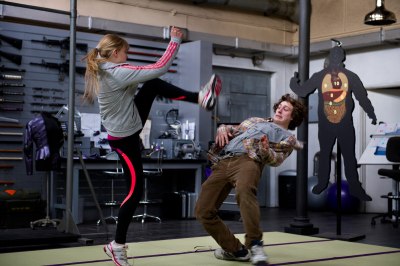
”The producers weren’t the only ones caught off guard by Wadlow’s initiative and chutzpah. Commends Millar: “Matthew was impressed with Jeff. He wanted somebody who was both a writer and a director, with vision and passion, and not to have that division of labor that you often get. Jeff was writing the story and telling the story as a director. A lot of things that Matthew’s very good at, Jeff happens to be good at as well, so we knew that the film would be in very capable hands.”
In bringing the characters back, Wadlow opted to dig deeper into the emotional aspects of their lives and expand our understanding of them. He says: “My idea from the beginning was this notion that Dave, Mindy and Chris still don’t know who they really are. In the first film, they created these alter egos—Kick-Ass, Hit Girl, Red Mist—but they hadn’t answered those larger questions that we all ask ourselves: ‘Who am I? What’s my place in this world? What am I going to do with my life?’ It’s one thing to try to be someone else, to be a superhero, but another to work out who you really are. I thought it would be interesting to have these characters ask themselves: ‘What’s behind that mask?’ Ultimately, the movie is about growing up.”
Wadlow feels that the greatest strength of Kick-Ass as a burgeoning franchise is that it doesn’t rely upon stock aphorisms common in genre fare. Wadlow continues: “It’s about the juxtapositions of superheroes and the real world. With Dave’s story, we put him in a situation where he’s trying to relate to other superheroes who are dealing with their real-world problems. With Mindy’s story, we put her in high school. For Chris’, we have him trying to be a super-villain in a world where it’s not easy to be one.”
Vaughn and Tarquin Pack’s fellow returning pro-ducers, Adam Bohling and David Reid, appreciated that Wadlow built upon the carefully constructed first film and brought an American sensibility to the story. Reflects Pack: “Kick-Ass had a quirky Englishness to it, whereas this sequel has a broader, more American, more mainstream feel. It still goes, by definition of the property, to places you can’t go to in most films, but Jeff handles it in an expansive manner. He has a strong visual sense and a strong idea of the movie that he wanted to make. As well, he’s had very clear input into what changes there have been in the costume and production design.”
To that point, Wadlow was more than okay with reassembling the skilled department heads from Kick-Ass—including production designer Russell De Rozario, editor Eddie Hamilton, costume designer Sammy Sheldon Differ and hair and makeup designer Fae Hammond. Says the writer/director: “Matthew told me, ‘These are the people I’m endorsing, as one filmmaker to another.’ I knew I should embrace everyone who worked on the first film. They did such an incredible job; there was no reason to bring in new people. I took this amazing toolbox that Matthew gave me and went to work.”
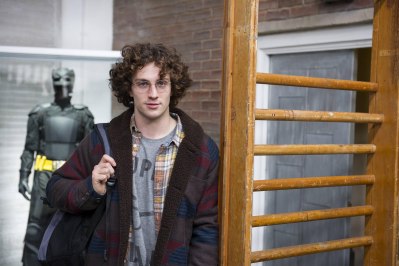
ASS KICKERS AND GRAVITY DOCTORS:
Who’s Who in the Action-Comedy?
Considering the number of characters trying to either save or destroy our fair metropolis, it is logical to walk the reader through who does what to whom. Below is a guide to understanding the brave superheroes and nasty super-villains who populate this world. They’re good, bad and/or ugly, but don’t underestimate these formerly ordinary folks who just want to kick some ass.
Kick-Ass and Hit Girl’s Inner Circle?
Dave Lizewski/Kick-Ass (Aaron Taylor-Johnson) is a New York teenage vigilante whose bravery inspired a new wave of self-made masked crusaders. With graduation looming and uncertain of his future plans, Dave decides to start the world’s first superhero team with Mindy, aka Hit Girl. When Mindy is busted for sneaking out as Hit Girl, Dave joins forces with Justice Forever, run by a born-again ex-mobster who calls himself Colonel Stars and Stripes.
Mindy Macready/Hit Girl (Chloë Grace Moretz) is a 14-year-old, blade-wielding, nunchaku-skilled force of nature who is going through the awkward stages of freshman year. Highly trained and heavily armed by her late father, Big Daddy, she still can’t escape the snide comments from the popular girls in her class. She’d rather kick some thug’s ass than face high school, so she sneaks out as soon as her guardian drops her off.
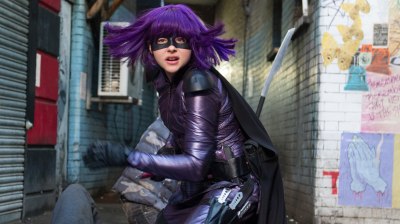
After Mindy’s father’s death at the hands of Frank D’Amico, Big Daddy’s old partner, Marcus Williams (MORRIS CHESTNUT), became her guardian. Marcus drops Mindy off at high school every day, but as soon as he leaves, so does she. He made Mindy promise she’d give up her blades under her bed every time he looks.
Marty/Battle Guy (CLARK DUKE) and Todd/Ass Kicker (AUGUSTUS PREW) are Dave’s comic-book collecting best friends. Though Marty plans to be premed at college, he has secretly developed a superhero persona named Battle Guy. Inspired by Kick-Ass, he excitedly joins Justice Forever. Todd’s future plans are up in the air, though he currently plans to attend a safety school in Florida to study golf course management. Wanting to be a part of something important, Todd is eager to join any team that will have him.
Katie Deauxma (LYNDSY FONSECA) is Dave’s super-cute girlfriend who is super-excited to get her life started. She plans to attend college, and Dave is expecting she’ll dump him as soon as she heads off. The cute couple has started suffering from boredom in the bedroom: She fantasizes about another guy while Dave daydreams about his English teacher.
Justice Forever
Sal Bertolini/Colonel Stars and Stripes (Jim Carrey) is a morally driven ex-mobster, a leader who is decked out in camouflage and an iconic mask. He patrols the streets with his trusted and masked sidekick, a German shepherd named Eisenhower. The Colonel created Justice Forever to protect people when the system fails, and he hates foul language as much as he hates evil.
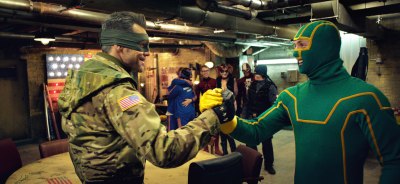
One of the more enthusiastic members of Justice Forever, Dr. Gravity (DONALD FAISON) is a copy-writer who pretends he’s a physics professor by day and a superhero by night. His physics “knowledge” comes in handy when he creates a zero-gravity device that can levitate any object up to a ton…but in fact, it’s just a baseball bat covered in tin foil.
A ballet teacher by day, Miranda Swedlow assumed her superhero persona, Night Bitch (LINDY BOOTH), after her sister was murdered. Although she is helping Justice Forever fight crime, Night Bitch also gets closer to its newest member, Kick-Ass…in every fast-food restaurant bathroom in the city.
Insect Man (ROBERT EMMS) has been bullied his entire life for being gay, so now he’s standing up for the defenseless. Armed with a taser (and an impossibly wealthy knowledge of bugs), Insect Man doesn’t need a mask to make the world a better place.
Tommy’s Mom and Dad/Remembering Tommy (MONICA DOLAN and STEVEN MACKINTOSH): In the comic series, Tommy’s Dad wears a homemade suit of armor, while Tommy’s Mom is dressed like an Amazonian warrior. In our story, they are decked out in T-shirts with the name “Remembering Tommy” to honor their son who vanished without a trace.
The Motherf%&*^r’s Super-Villains
The spoiled son of deceased crime boss Frank D’Amico, Chris D’Amico/Red Mist/ The Mother f%&*^r (Christopher Mintz-Plasse) has grown obsessed with taking revenge on Kick-Ass, who blew up Frank with a bazooka. After Chris’ mother’s (YANCY BUTLER) untimely death, Red Mist—freshly dressed in her old fetish gear and cape—is reborn as The Mother f%&*^r. So begins the richest kid in New York City’s quest to become the world’s first real super-villain.
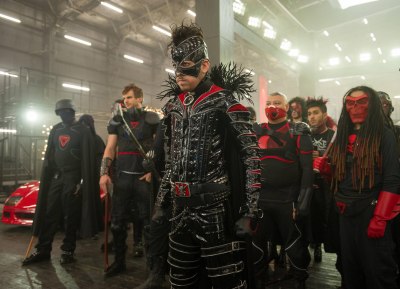
Javier (JOHN LEGUIZAMO) is Chris’ bodyguard, and he’s reluctant to call his employer by an up graded super-villain name (he had a hard enough time calling him Red Mist). The Alfred to his boss’ evil Bruce Wayne, Javier is tasked with helping The Mother f%&*^r expand his super-villain team. Now that Chris has lost both parents, Javier is the only real family he has left.
The highest-paid member of The Mother f%&*^r’s team, Katarina Dombrovski/Mother Russia (OLGA KURKULINA) is a bodybuilder and former KGB member who can beat anyone to a pulp. She was locked up in the Gulag…until she ate her cellmate and escaped.
Black Death (DANIEL KALUUYA), of course named as such by The Mother f%&*^r, met Chris at an MMA gym, where he promptly kicked Chris’ ass to the mat. Impressed, Chris hired Black Death to beat up anyone on his hit list.
Chris insists that his underling’s names aren’t racial stereotypes, they’re archetypes. Genghis Carnage (TOM WU) is a former Chinese gangster who is looking for a new boss. The Mother f%&*^r hires him to do his heavy lifting and heavier attacking.
Big Tony/The Tumor (ANDY NYMAN) is reminiscent of one of our favorite Goodfellas…all 5 feet 2 inches of him. Although this psychotic killer may be small, he’s mean as hell and will stab you with a broken pool cue if you look at him funny.
IT’S BIOLOGY, BITCH:
Kick-Ass, Hit Girl and Red Mist Grow Up
As he crafted the story, Wadlow wanted Kick-Ass 2 to give fans another chance to see three characters that they fell in love with, to see how they have grown and how they will continue to change. The writer/director reflects: “I hope it resonates with audiences because it’s not just a retread of the first movie. It’s not one of those sequels that says, ‘Hey! Remember how much you loved the first movie? Well, here’s another version of that.’”
If anything, his story does the exact opposite. Wadlow adds: “We say, ‘Remember how much you loved those characters? Well, guess what? We’re going to put them through a meat grinder.’ We’ve sent them on this journey where they’re going to grow and change in ways you can’t imagine. We’ve pushed them further than you could in a first film because of all that screen time you needed to use getting to know them. We assume you already know and like them, and we’re going to take all that time and push them even further.”
While a sequel was always a finger-crossed hope, it had actually been four years since the original cast made Kick-Ass. At the end of that film, Dave goes back to his old life, and his alter ego is gone but not forgotten by a new wave of aspiring superheroes. However, life after Kick-Ass moved on significantly for the actor who was portraying the hero. Now married and a father of two, Aaron Taylor-Johnson had been working for the likes of Oliver Stone and Joe Wright but always remained interested in revisiting his breakout role, if the filmmakers could deliver something as equally original and refreshing as Kick-Ass.
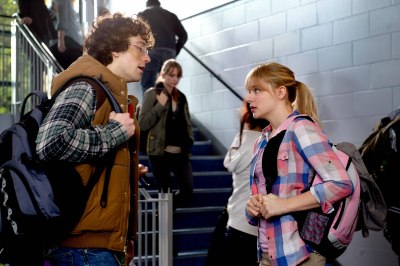
The British performer appreciated that Dave was never out to hurt anyone. He simply wanted to stand up for the helpless while others sat idle. Taylor-Johnson reflects: “What’s great about Dave is that he doesn’t want to kill people. Mindy, for fun, will slice someone’s hand off, but that’s not what inspired Dave to become a superhero. For him, it’s about being good, about fighting crime and not becoming part of it.”
Wadlow’s taut script ensured his return: “Jeff did a fantastic job,” commends Taylor-Johnson. “We all loved it, and that’s the main reason it took off.” Discussing how it feels to step back into the part, the actor says: “It’s bizarre repeating something you’ve already done, so I needed to step it up a few levels. Dave is the person we already know, but he’s beginning to discover himself, growing into a man and taking responsibility for his actions. This time, the consequences weigh heavily on his shoulders, and he really understands that.”
Taylor-Johnson felt as the producers did: Wadlow’s script brought a deep emotional core to a story about a young man who discovers his mission to try and save others. “From the moment we met, we connected,” adds the performer. “He was sincere and passionate about it, and interested in creating a journey for Dave. It was never just about how much action we could deliver. Behind the stunts and the fighting, there’s always a motive. You must start to link the emotion to the motive that is behind the punch, and Jeff was interested in developing that.”
Wadlow admits that Taylor-Johnson’s work in the first movie drew him to pushing to develop the second chapter of Dave/Kick-Ass’ story. When the filmmaker met the actor, he was even more impressed: “I have so much respect for Aaron. While many actors approach their role wanting to look cool—to always be appealing, to be the center of attention in each scene—what they lose sight of is that we’re telling a story, which their character is a piece of, even if they’re the lead. It was clear to me from the moment I met Aaron how special he was. He immediately started talking about the story and the role that Dave plays in telling that story, as well as what he could do to help it along. He wanted the lamest tennis shoes, ill-fitting T-shirts and a dorky haircut for Dave when we first reconnect with him.”
Kick-Ass wouldn’t be half the hero he is without Hit Girl, and no sequel would begin production without her in the mix. Imagined by Millar as a tribute to his eldest daughter, Hit Girl has struck a chord with readers since her introduction and grown exponentially in popularity. The young woman who brought her to life, Chloë Grace Moretz, has been working up a storm—earning critical acclaim in such fare as Let Me In, as well as working with the likes of Martin Scorsese in Hugo and Tim Burton in Dark Shadows and soon to be seen starring opposite Julianne Moore as the title character in the remake of Carrie. Like her co-stars, she was thrilled to step back into her Kick-Ass role as Hit Girl, unfazed by the commotion caused by her appearance the first time around.
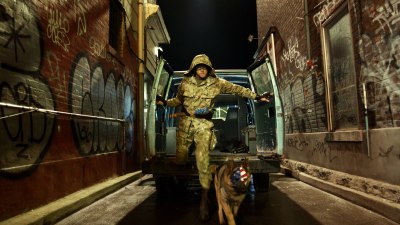
For the 2010 film, the now 16-year-old actress took the world by roundhouse kick with not only her acting abilities, but her phenomenal mastery of weaponry and martial arts. Indeed, Moretz didn’t know she was prescient when she joked at the premiere of the first film that she wanted to ride a purple Ducati: Hit Girl’s bike of choice in Kick-Ass 2. Laughs Moretz: “To get in the costume again and do all the stunts was pretty amazing. I’ve had such a great time reliving the character and bringing in more dimensions, while taking an older approach to the role. I liked seeing what I could play with in the part.”
We meet a now-orphaned 9th grader in Kick-Ass 2, a girl who is more terrified of the treacherous girls in school than she ever was of the villains that she and Big Daddy took down. Moretz describes where we meet Mindy: “She’s skipping school, still being a vigilante and caring more about Hit Girl’s life than Mindy’s. Because she doesn’t have Big Daddy anymore, and Marcus is much more of a normal parent than Big Daddy, she starts to question herself. She promises Marcus she’ll stop being Hit Girl and begins to figure out her life a bit. The thing is…Mindy can’t really change.”
One of Hit Girl’s creators discusses Hit Girl’s evolution in dealing with a different kind of villain: teenage girls, led by queen bee/varsity dance captain Brooke (CLAUDIA LEE). Romita offers: “Mindy’s not the normal child. So instead of going home and crying and punching a pillow, she enacts revenge in a certain way that everybody wishes they could enact on a bully. She’s teaching Kick-Ass how to be a superhero and he’s teaching her how to be a normal girl.”
Drawing on the source material, Wadlow and the producers were interested in exploring what happens when Mindy stops being Hit Girl and grapples with life and love as a high-school student. The director felt that no other performer but Moretz could possibly deliver that. He says: “There’s something incredibly special about Chloë that is hard to describe and quantify, but when you see her on screen you instantly understand. As a director, it was exciting for me to work with someone like her, because normally I like to dissect the character and intellectualize the story. Chloë just gets it immediately; she doesn’t need me to pontificate.”
Wadlow found that the usual manner of directing an actor wouldn’t work with Moretz. He proudly says: “Chloë understands how to create a moment in a way that you can’t teach or talk about it. She just does it, and she does it every take. It’s funny because we’d talk about a scene, about where I wanted it to go or how it fits into the larger story, and sometimes I’d wonder if what I was saying even made sense. But then we’d shoot it, and Chloë would deliver—take after take. I don’t think of her as a kid at all. I talk to her as a peer because she is so incredibly savvy and mature, but also willing to be goofy and not at all self-conscious. She’s just an amazing actress.”
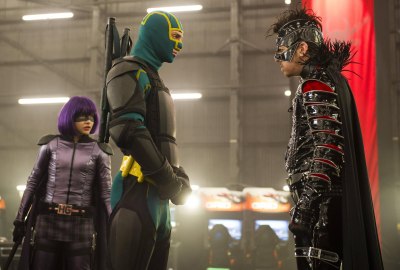
Rounding out the trio of returning badasses is Chris D’Amico. At the end of Kick-Ass, Chris’ alter ego, Red Mist, turns to the camera and says, “As a great man once said, ‘Wait ’til they get a load of me.’ A nod to Jack Nicholson’s Joker in Tim Burton’s Batman, this hints at the super-villain he plans to become: a young man obsessed with avenging the death of his father and assembling a group of fellow super-villains to lead. It was lucky then that Christopher Mintz-Plasse was ready to sign up for another outing. In the intervening years since he shot the first movie, Mintz-Plasse has been extremely busy on screens big and small: lending his voice to DreamWorks Animation’s How to Train Your Dragon and Focus Features’ ParaNorman, appearing in the hit comedies This Is the End and Pitch Perfect, as well as in television series including The Far Cry Experience and Friend Me.
Although Chris D’Amico has now inherited his family fortune, he is still very much a bad guy in training. And although his Uncle Ralph (IAIN GLEN) is in maximum security at Riker’s Island, Ralph is still ruling over the local Mafia. That won’t stop Chris from evolving into something even more evil. “It’s great to be back in this world,” says the performer, “though it’s a lot different now. My father’s dead, my mom is a pill-popping psycho, and Red Mist has turned to the dark side and is obsessed with killing Kick-Ass.” Hell-bent on recruiting an evil army, Red Mist reinvents himself as The Mother f%&*^r and gets ready to wreak havoc on New York City, with a single-minded obsession to kill Kick-Ass.
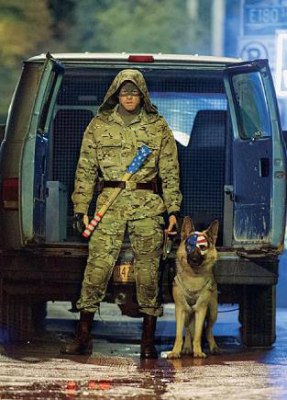
Mintz-Plasse discusses his full evolution: “Chris slowly starts to realize he’s becoming The Mother-f%&*^r. He’s lost everybody he loves: all his friends, all his family, and he’s lost himself too. Once he puts on that full outfit and loses Javier, he’s no longer Chris D’Amico. He’s only The Mother f%&*^r.”
Wadlow was as impressed with Mintz-Plasse as he was with his other two leads. He commends: “Chris is a comedic genius. He is so funny, so fearless and a tremendous actor—so much more than just a comedic actor. He is phenomenal in this film, and people are going to be blown away by what he does. I would like to take some credit for it, like somehow I had this grand plan for him, but all the credit goes to him because he knocked it out of the park.”
“Kick-Ass,” the revolutionary creator-owned comic that Mark Millar launched with artist John S. Romita Jr. in 2008, challenged curious readers with one simple question: “Why has nobody ever tried to become a superhero?” The two men answered that query with a barrage of violence, memorable characters and quotable dialogue.
Freshly buoyed by the blockbuster success of the Universal actioner Wanted—based on his same-titled book—Millar began to explore the possibility of bringing “Kick-Ass” to the big screen. Because “Kick-Ass” was an independent comic, this allowed the creators greater freedom in approaching production partners who would appreciate the series’ bracingly unique storylines.
Around that time, director Matthew Vaughn was looking for his next project and had recently been introduced to Millar by Stardust co-writer Jane Goldman and her husband, Jonathan Ross. Millar later pitched Vaughn a number of ideas, but it was Kick-Ass that resonated most. Vaughn was determined to apply the same anarchic spirit of the comic to the filmic version—even if that meant including scenes in which an 11-year-old Hit Girl mows down dozens of heavily armed men with an arsenal of weaponry and a string of expletives. When turned down by Hollywood’s major studios, Vaughn decided to finance Kick-Ass independently.
Scripted by Goldman and Vaughn, Kick-Ass brought to the screen the wild story of Dave Lizewski, an ordinary Manhattan teenager who sets out to become a real-life superhero. Donning a green-and-yellow wet suit and calling himself Kick-Ass, he captures the imagination of the public and becomes an online phenomenon. Kick-Ass soon discovers he is not the city’s only superhero when he meets a fearless and highly trained father-daughter crime-fighting duo—the cowl-draped Big Daddy and ninja assassin Hit Girl. As Kick-Ass becomes entangled in their quest to take down the criminal empire of local mafioso Frank D’Amico, our hero gains a nemesis of his own: Frank’s teenage son, Chris, who has taken to calling himself Red Mist.

The movie was nothing short of a huge gamble, but one that the filmmakers were prepared to take. Kick-Ass was lensed in 2008, with Vaughn showing it to potential distributors a year later. He subsequently sealed deals with Lionsgate and Universal Pictures to release it in the U.S. and internationally, respectively, in 2010. Kick-Ass was met with astonishing reviews such as Richard Corliss’ Time magazine rave: “It soars, jet-propelled, on its central idea of matching a superhero’s exploits with the grinding reality of urban teen life and on the aerodynamic smoothness of the film’s style.”
Although the groundbreaking film caused some critics to raise their eyebrows in dismay, it was adored by audiences who understood Vaughn’s strong desire to upend the genre. In turn, the movie pulled in almost $100 million globally, proved enormously successful on DVD/Blu-ray metrics and gained a passionate following along the way.
All the while, Millar and Romita continued the work on their homegrown saga. The first chapter of their follow-up comic series, “Kick-Ass 2, Issue 1,” debuted on October 20, 2010. Set several months after the events of the first run, the books reconnect us with Mindy and Dave as they struggle to keep their identities as Hit Girl and Kick-Ass a secret—while she trains him to be a better hero who can take a much-less-forgiving punch. Meanwhile, Red Mist returns with an increasingly psychotic new attitude and an unprintable name change to match. Forming a group of super-villains, Chris takes the deadly game to the next level as he attempts to exterminate the duo that killed his reprobate father.
Twenty-four hours after its release, “Kick-Ass 2, Issue 1” sold out, and the “Hit Girl” companion title has since become the most popular comic book with a female lead in more than a decade. The first two chapters of the “Kick-Ass 3” series are currently in release, completing the trilogy and bringing Dave Lizewski’s story to an exciting finish later this year.
Millar walks us through the evolution of this sig-nature property: “Kick-Ass was about a guy deciding to become a superhero and influencing others to do the same. Kick-Ass 2 takes that idea and runs with it. Now we have this group of people who, inspired by the heroics of Kick-Ass, have formed a crime-fighting gang, Justice Forever. At the same time, Chris is embarking on the opposite journey. He has decided to become a self-proclaimed super-villain and is recruiting his own army. It takes something that was singular in the first movie and makes it into something more exciting. It’s that sense of escalation, of expansion, that you always want with a sequel.”

As Millar and Romita created the characters and own the rights to them, the two men take the fate of our every-day superheroes very seriously. Romita explains that he and Millar have just as much invested in the fate of Dave, Mindy and the other members of Justice Forever as the diehard fans do, and it is tough to create bad situations that happen to them. The artist says: “All of the interesting characters that are in Justice Forever, you want them to win. Here I am, a comic book artist, and I want these characters to be superheroes because I don’t want anything bad happening to them.”
Kick-Ass’ unexpected success, set the stage for a sequel; however, it would take a couple years for the next chapter to begin production. Kicking off in 2011, Vaughn met with Cry_Wolf director Jeff Wadlow to discuss a project known as Bloodshot. Wadlow had written the screenplay, and Vaughn was attached to direct.
Other commitments resulted in Vaughn’s inability to continue with Bloodshot, but he remained interested in working with this intriguing young director. When Vaughn’s obligations to the X-Men franchise wrapped him up for the foreseeable future, the filmmaker pondered abdicating both writing and directing duties to Wadlow, which would allow Vaughn to remain involved as a producer.
Wadlow was so adamant that Vaughn pass the mantle on to him, he set to work on a script without a deal yet in place. The filmmaker recalls: “I wrote it to direct it, and I wasn’t going to let anyone else do it. That’s the upside of taking on the risk of writing the script without a deal in place, initially. Even though Matthew and I talked a lot, I jumped before there was any real plan in place. I wanted to make the movie, and so I wrote it to make it.”
Vaughn offers that Wadlow was just the director to take the reins. He commends: “Jeff’s pitch for Bloodshot was damn impressive, and then his script came in. It was exactly what his pitch was, which in Hollywood is very rare. I liked him, and he had a passion for comics, especially for ‘Kick-Ass.’” Still, the passing of the torch wasn’t immediate. Reflects Vaughn: “Even though I want to give people breaks, it was a weird decision to hand this over to a director. I thought I have to find the right person who is hungry, but has experience and is passionate. As well, I like writer/directors because it means they can know how to write a screenplay. Sometimes, you can have a great script then you hire a director who does something totally different with it.
"The producer catches us up with where Wadlow—basing his screenplay on Millar and Romita’s source material—has taken our heroes: “Dave goes to Mindy and says, ‘Look, train me up. I want to do this properly, and you and I can be the new Dynamic Duo.’ Just as Dave’s getting good and they’re enjoying it, Mindy has to give it up. She makes a promise that she won’t be Hit Girl anymore, and then Dave’s left to his own devices. He’s scared to do it on his own, so he teams up with a bunch of wannabe superheroes. But eight wannabe superheroes are still not replacing one little Hit Girl.

”The producers weren’t the only ones caught off guard by Wadlow’s initiative and chutzpah. Commends Millar: “Matthew was impressed with Jeff. He wanted somebody who was both a writer and a director, with vision and passion, and not to have that division of labor that you often get. Jeff was writing the story and telling the story as a director. A lot of things that Matthew’s very good at, Jeff happens to be good at as well, so we knew that the film would be in very capable hands.”
In bringing the characters back, Wadlow opted to dig deeper into the emotional aspects of their lives and expand our understanding of them. He says: “My idea from the beginning was this notion that Dave, Mindy and Chris still don’t know who they really are. In the first film, they created these alter egos—Kick-Ass, Hit Girl, Red Mist—but they hadn’t answered those larger questions that we all ask ourselves: ‘Who am I? What’s my place in this world? What am I going to do with my life?’ It’s one thing to try to be someone else, to be a superhero, but another to work out who you really are. I thought it would be interesting to have these characters ask themselves: ‘What’s behind that mask?’ Ultimately, the movie is about growing up.”
Wadlow feels that the greatest strength of Kick-Ass as a burgeoning franchise is that it doesn’t rely upon stock aphorisms common in genre fare. Wadlow continues: “It’s about the juxtapositions of superheroes and the real world. With Dave’s story, we put him in a situation where he’s trying to relate to other superheroes who are dealing with their real-world problems. With Mindy’s story, we put her in high school. For Chris’, we have him trying to be a super-villain in a world where it’s not easy to be one.”
Vaughn and Tarquin Pack’s fellow returning pro-ducers, Adam Bohling and David Reid, appreciated that Wadlow built upon the carefully constructed first film and brought an American sensibility to the story. Reflects Pack: “Kick-Ass had a quirky Englishness to it, whereas this sequel has a broader, more American, more mainstream feel. It still goes, by definition of the property, to places you can’t go to in most films, but Jeff handles it in an expansive manner. He has a strong visual sense and a strong idea of the movie that he wanted to make. As well, he’s had very clear input into what changes there have been in the costume and production design.”
To that point, Wadlow was more than okay with reassembling the skilled department heads from Kick-Ass—including production designer Russell De Rozario, editor Eddie Hamilton, costume designer Sammy Sheldon Differ and hair and makeup designer Fae Hammond. Says the writer/director: “Matthew told me, ‘These are the people I’m endorsing, as one filmmaker to another.’ I knew I should embrace everyone who worked on the first film. They did such an incredible job; there was no reason to bring in new people. I took this amazing toolbox that Matthew gave me and went to work.”

ASS KICKERS AND GRAVITY DOCTORS:
Who’s Who in the Action-Comedy?
Considering the number of characters trying to either save or destroy our fair metropolis, it is logical to walk the reader through who does what to whom. Below is a guide to understanding the brave superheroes and nasty super-villains who populate this world. They’re good, bad and/or ugly, but don’t underestimate these formerly ordinary folks who just want to kick some ass.
Kick-Ass and Hit Girl’s Inner Circle?
Dave Lizewski/Kick-Ass (Aaron Taylor-Johnson) is a New York teenage vigilante whose bravery inspired a new wave of self-made masked crusaders. With graduation looming and uncertain of his future plans, Dave decides to start the world’s first superhero team with Mindy, aka Hit Girl. When Mindy is busted for sneaking out as Hit Girl, Dave joins forces with Justice Forever, run by a born-again ex-mobster who calls himself Colonel Stars and Stripes.
Mindy Macready/Hit Girl (Chloë Grace Moretz) is a 14-year-old, blade-wielding, nunchaku-skilled force of nature who is going through the awkward stages of freshman year. Highly trained and heavily armed by her late father, Big Daddy, she still can’t escape the snide comments from the popular girls in her class. She’d rather kick some thug’s ass than face high school, so she sneaks out as soon as her guardian drops her off.

After Mindy’s father’s death at the hands of Frank D’Amico, Big Daddy’s old partner, Marcus Williams (MORRIS CHESTNUT), became her guardian. Marcus drops Mindy off at high school every day, but as soon as he leaves, so does she. He made Mindy promise she’d give up her blades under her bed every time he looks.
Marty/Battle Guy (CLARK DUKE) and Todd/Ass Kicker (AUGUSTUS PREW) are Dave’s comic-book collecting best friends. Though Marty plans to be premed at college, he has secretly developed a superhero persona named Battle Guy. Inspired by Kick-Ass, he excitedly joins Justice Forever. Todd’s future plans are up in the air, though he currently plans to attend a safety school in Florida to study golf course management. Wanting to be a part of something important, Todd is eager to join any team that will have him.
Katie Deauxma (LYNDSY FONSECA) is Dave’s super-cute girlfriend who is super-excited to get her life started. She plans to attend college, and Dave is expecting she’ll dump him as soon as she heads off. The cute couple has started suffering from boredom in the bedroom: She fantasizes about another guy while Dave daydreams about his English teacher.
Justice Forever
Sal Bertolini/Colonel Stars and Stripes (Jim Carrey) is a morally driven ex-mobster, a leader who is decked out in camouflage and an iconic mask. He patrols the streets with his trusted and masked sidekick, a German shepherd named Eisenhower. The Colonel created Justice Forever to protect people when the system fails, and he hates foul language as much as he hates evil.

One of the more enthusiastic members of Justice Forever, Dr. Gravity (DONALD FAISON) is a copy-writer who pretends he’s a physics professor by day and a superhero by night. His physics “knowledge” comes in handy when he creates a zero-gravity device that can levitate any object up to a ton…but in fact, it’s just a baseball bat covered in tin foil.
A ballet teacher by day, Miranda Swedlow assumed her superhero persona, Night Bitch (LINDY BOOTH), after her sister was murdered. Although she is helping Justice Forever fight crime, Night Bitch also gets closer to its newest member, Kick-Ass…in every fast-food restaurant bathroom in the city.
Insect Man (ROBERT EMMS) has been bullied his entire life for being gay, so now he’s standing up for the defenseless. Armed with a taser (and an impossibly wealthy knowledge of bugs), Insect Man doesn’t need a mask to make the world a better place.
Tommy’s Mom and Dad/Remembering Tommy (MONICA DOLAN and STEVEN MACKINTOSH): In the comic series, Tommy’s Dad wears a homemade suit of armor, while Tommy’s Mom is dressed like an Amazonian warrior. In our story, they are decked out in T-shirts with the name “Remembering Tommy” to honor their son who vanished without a trace.
The Motherf%&*^r’s Super-Villains
The spoiled son of deceased crime boss Frank D’Amico, Chris D’Amico/Red Mist/ The Mother f%&*^r (Christopher Mintz-Plasse) has grown obsessed with taking revenge on Kick-Ass, who blew up Frank with a bazooka. After Chris’ mother’s (YANCY BUTLER) untimely death, Red Mist—freshly dressed in her old fetish gear and cape—is reborn as The Mother f%&*^r. So begins the richest kid in New York City’s quest to become the world’s first real super-villain.

Javier (JOHN LEGUIZAMO) is Chris’ bodyguard, and he’s reluctant to call his employer by an up graded super-villain name (he had a hard enough time calling him Red Mist). The Alfred to his boss’ evil Bruce Wayne, Javier is tasked with helping The Mother f%&*^r expand his super-villain team. Now that Chris has lost both parents, Javier is the only real family he has left.
The highest-paid member of The Mother f%&*^r’s team, Katarina Dombrovski/Mother Russia (OLGA KURKULINA) is a bodybuilder and former KGB member who can beat anyone to a pulp. She was locked up in the Gulag…until she ate her cellmate and escaped.
Black Death (DANIEL KALUUYA), of course named as such by The Mother f%&*^r, met Chris at an MMA gym, where he promptly kicked Chris’ ass to the mat. Impressed, Chris hired Black Death to beat up anyone on his hit list.
Chris insists that his underling’s names aren’t racial stereotypes, they’re archetypes. Genghis Carnage (TOM WU) is a former Chinese gangster who is looking for a new boss. The Mother f%&*^r hires him to do his heavy lifting and heavier attacking.
Big Tony/The Tumor (ANDY NYMAN) is reminiscent of one of our favorite Goodfellas…all 5 feet 2 inches of him. Although this psychotic killer may be small, he’s mean as hell and will stab you with a broken pool cue if you look at him funny.
IT’S BIOLOGY, BITCH:
Kick-Ass, Hit Girl and Red Mist Grow Up
As he crafted the story, Wadlow wanted Kick-Ass 2 to give fans another chance to see three characters that they fell in love with, to see how they have grown and how they will continue to change. The writer/director reflects: “I hope it resonates with audiences because it’s not just a retread of the first movie. It’s not one of those sequels that says, ‘Hey! Remember how much you loved the first movie? Well, here’s another version of that.’”
If anything, his story does the exact opposite. Wadlow adds: “We say, ‘Remember how much you loved those characters? Well, guess what? We’re going to put them through a meat grinder.’ We’ve sent them on this journey where they’re going to grow and change in ways you can’t imagine. We’ve pushed them further than you could in a first film because of all that screen time you needed to use getting to know them. We assume you already know and like them, and we’re going to take all that time and push them even further.”
While a sequel was always a finger-crossed hope, it had actually been four years since the original cast made Kick-Ass. At the end of that film, Dave goes back to his old life, and his alter ego is gone but not forgotten by a new wave of aspiring superheroes. However, life after Kick-Ass moved on significantly for the actor who was portraying the hero. Now married and a father of two, Aaron Taylor-Johnson had been working for the likes of Oliver Stone and Joe Wright but always remained interested in revisiting his breakout role, if the filmmakers could deliver something as equally original and refreshing as Kick-Ass.

The British performer appreciated that Dave was never out to hurt anyone. He simply wanted to stand up for the helpless while others sat idle. Taylor-Johnson reflects: “What’s great about Dave is that he doesn’t want to kill people. Mindy, for fun, will slice someone’s hand off, but that’s not what inspired Dave to become a superhero. For him, it’s about being good, about fighting crime and not becoming part of it.”
Wadlow’s taut script ensured his return: “Jeff did a fantastic job,” commends Taylor-Johnson. “We all loved it, and that’s the main reason it took off.” Discussing how it feels to step back into the part, the actor says: “It’s bizarre repeating something you’ve already done, so I needed to step it up a few levels. Dave is the person we already know, but he’s beginning to discover himself, growing into a man and taking responsibility for his actions. This time, the consequences weigh heavily on his shoulders, and he really understands that.”
Taylor-Johnson felt as the producers did: Wadlow’s script brought a deep emotional core to a story about a young man who discovers his mission to try and save others. “From the moment we met, we connected,” adds the performer. “He was sincere and passionate about it, and interested in creating a journey for Dave. It was never just about how much action we could deliver. Behind the stunts and the fighting, there’s always a motive. You must start to link the emotion to the motive that is behind the punch, and Jeff was interested in developing that.”
Wadlow admits that Taylor-Johnson’s work in the first movie drew him to pushing to develop the second chapter of Dave/Kick-Ass’ story. When the filmmaker met the actor, he was even more impressed: “I have so much respect for Aaron. While many actors approach their role wanting to look cool—to always be appealing, to be the center of attention in each scene—what they lose sight of is that we’re telling a story, which their character is a piece of, even if they’re the lead. It was clear to me from the moment I met Aaron how special he was. He immediately started talking about the story and the role that Dave plays in telling that story, as well as what he could do to help it along. He wanted the lamest tennis shoes, ill-fitting T-shirts and a dorky haircut for Dave when we first reconnect with him.”
Kick-Ass wouldn’t be half the hero he is without Hit Girl, and no sequel would begin production without her in the mix. Imagined by Millar as a tribute to his eldest daughter, Hit Girl has struck a chord with readers since her introduction and grown exponentially in popularity. The young woman who brought her to life, Chloë Grace Moretz, has been working up a storm—earning critical acclaim in such fare as Let Me In, as well as working with the likes of Martin Scorsese in Hugo and Tim Burton in Dark Shadows and soon to be seen starring opposite Julianne Moore as the title character in the remake of Carrie. Like her co-stars, she was thrilled to step back into her Kick-Ass role as Hit Girl, unfazed by the commotion caused by her appearance the first time around.

For the 2010 film, the now 16-year-old actress took the world by roundhouse kick with not only her acting abilities, but her phenomenal mastery of weaponry and martial arts. Indeed, Moretz didn’t know she was prescient when she joked at the premiere of the first film that she wanted to ride a purple Ducati: Hit Girl’s bike of choice in Kick-Ass 2. Laughs Moretz: “To get in the costume again and do all the stunts was pretty amazing. I’ve had such a great time reliving the character and bringing in more dimensions, while taking an older approach to the role. I liked seeing what I could play with in the part.”
We meet a now-orphaned 9th grader in Kick-Ass 2, a girl who is more terrified of the treacherous girls in school than she ever was of the villains that she and Big Daddy took down. Moretz describes where we meet Mindy: “She’s skipping school, still being a vigilante and caring more about Hit Girl’s life than Mindy’s. Because she doesn’t have Big Daddy anymore, and Marcus is much more of a normal parent than Big Daddy, she starts to question herself. She promises Marcus she’ll stop being Hit Girl and begins to figure out her life a bit. The thing is…Mindy can’t really change.”
One of Hit Girl’s creators discusses Hit Girl’s evolution in dealing with a different kind of villain: teenage girls, led by queen bee/varsity dance captain Brooke (CLAUDIA LEE). Romita offers: “Mindy’s not the normal child. So instead of going home and crying and punching a pillow, she enacts revenge in a certain way that everybody wishes they could enact on a bully. She’s teaching Kick-Ass how to be a superhero and he’s teaching her how to be a normal girl.”
Drawing on the source material, Wadlow and the producers were interested in exploring what happens when Mindy stops being Hit Girl and grapples with life and love as a high-school student. The director felt that no other performer but Moretz could possibly deliver that. He says: “There’s something incredibly special about Chloë that is hard to describe and quantify, but when you see her on screen you instantly understand. As a director, it was exciting for me to work with someone like her, because normally I like to dissect the character and intellectualize the story. Chloë just gets it immediately; she doesn’t need me to pontificate.”
Wadlow found that the usual manner of directing an actor wouldn’t work with Moretz. He proudly says: “Chloë understands how to create a moment in a way that you can’t teach or talk about it. She just does it, and she does it every take. It’s funny because we’d talk about a scene, about where I wanted it to go or how it fits into the larger story, and sometimes I’d wonder if what I was saying even made sense. But then we’d shoot it, and Chloë would deliver—take after take. I don’t think of her as a kid at all. I talk to her as a peer because she is so incredibly savvy and mature, but also willing to be goofy and not at all self-conscious. She’s just an amazing actress.”

Rounding out the trio of returning badasses is Chris D’Amico. At the end of Kick-Ass, Chris’ alter ego, Red Mist, turns to the camera and says, “As a great man once said, ‘Wait ’til they get a load of me.’ A nod to Jack Nicholson’s Joker in Tim Burton’s Batman, this hints at the super-villain he plans to become: a young man obsessed with avenging the death of his father and assembling a group of fellow super-villains to lead. It was lucky then that Christopher Mintz-Plasse was ready to sign up for another outing. In the intervening years since he shot the first movie, Mintz-Plasse has been extremely busy on screens big and small: lending his voice to DreamWorks Animation’s How to Train Your Dragon and Focus Features’ ParaNorman, appearing in the hit comedies This Is the End and Pitch Perfect, as well as in television series including The Far Cry Experience and Friend Me.
Although Chris D’Amico has now inherited his family fortune, he is still very much a bad guy in training. And although his Uncle Ralph (IAIN GLEN) is in maximum security at Riker’s Island, Ralph is still ruling over the local Mafia. That won’t stop Chris from evolving into something even more evil. “It’s great to be back in this world,” says the performer, “though it’s a lot different now. My father’s dead, my mom is a pill-popping psycho, and Red Mist has turned to the dark side and is obsessed with killing Kick-Ass.” Hell-bent on recruiting an evil army, Red Mist reinvents himself as The Mother f%&*^r and gets ready to wreak havoc on New York City, with a single-minded obsession to kill Kick-Ass.

Mintz-Plasse discusses his full evolution: “Chris slowly starts to realize he’s becoming The Mother-f%&*^r. He’s lost everybody he loves: all his friends, all his family, and he’s lost himself too. Once he puts on that full outfit and loses Javier, he’s no longer Chris D’Amico. He’s only The Mother f%&*^r.”
Wadlow was as impressed with Mintz-Plasse as he was with his other two leads. He commends: “Chris is a comedic genius. He is so funny, so fearless and a tremendous actor—so much more than just a comedic actor. He is phenomenal in this film, and people are going to be blown away by what he does. I would like to take some credit for it, like somehow I had this grand plan for him, but all the credit goes to him because he knocked it out of the park.”
« Previous | 1 | 2 | 3 | 4 | 5 | Next »










